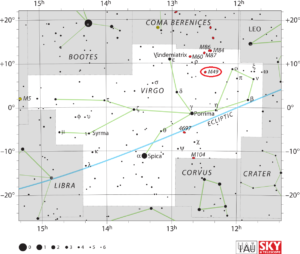The elliptical galaxy M49 was discovered by Charles Messier in 1771. Not only was it the first object discovered in the Virgo Cluster of galaxies, but it was also the first elliptical galaxy detected outside of the Milky Way’s Local Group. Unlike spiral galaxies that have well-defined structures and picturesque spiral arms, elliptical galaxies are fairly featureless with little structure. The stars in elliptical galaxies are usually much older than those in spiral galaxies. M49 also contains a rich collection of globular star clusters — nearly 6,000. There is a supermassive block hole in the center.
It is the most luminous member of that cluster and more luminous than any galaxy closer to the Earth.
| Description | |
| Visible From Pacific Northwest | December To May |
| Best Time To Observe | March, April, and May |
| Minimum Size Of Viewing Device | 15 X 70 Binoculars |
| Object Type | Elliptical Galaxy |
| Designations | Messier 49, M49, NGC 4472, Arp 134, PGC 41220, UGC 7629, VCC 1226, XSS J12312+0833, RGB J1229.8+0800, GIN 781 |
| Right Ascension | 12h 29m 46.7s |
| Declination | +08°00’02” |
| Constellation | Virgo |
| Number Of Stars | Moree Than 200 Billion |
| Apparent magnitude | +9.4 |
| Apparent dimensions | 10.2 x 8.3 arc minutes |
| Object Radius | 157,000 light years |
| Distance From Earth | 55.9 Million Light Years |
History
Messier 49 was discovered by Charles Messier on February 19, 1771.
The object was discovered independently by the Italian astronomer Barnaba Oriani on April 22, 1779. Oriani described the “nebula” as “very pale and looking exactly like the comet [1779 Bode, C/1779 A1].” The discovery of M49 was later erroneously attributed to Oriani by Admiral William Henry Smyth in his 1844 Bedford Catalogue, by John Herschel in his 1864 General Catalogue and by John Louis Emil Dreyer in the New General Catalogue.
John Herschel catalogued the object as GC 3021, noting, “Very bright; very large; described by W.H. as elongated, by J.H. as round; much brighter toward the middle.”
John Louis Emil Dreyer, who catalogued M49 as NGC 4472, offered a similar description of the object: “Very bright, large, round, much brighter toward the middle, mottled.”
Locating M49 In The Sky
Galaxy hopping isn’t an easy chore and it takes some practice. Starting looking for M49 about halfway between Epsilon and Beta Virginis. Use Gamma to help triangulate your position. At near magnitude 8, Messier 49 is quite binocular possible and would show under dark sky conditions as a faint, very small egg shaped fog. However, it will not show in a finderscope of a telescope – but the nearby stars will.

Viewing M49
In good conditions, M49 appears as a hazy patch of light in large 15×70 binoculars, while 4-inch telescopes reveal the galaxy’s bright core. 8-inch and larger telescopes show both its bright centre and large halo. However, the galaxy appears mostly featureless and does not get resolved even in larger instruments.
Photographing M49
Imaging Messier 49 requires accurate autogiuding. Messier 49 is not necessarily a popular target, but provide beautiful images. There are a plethora of options to image it.
https://www.astrobin.com/299302/C/?nc=user
https://www.astrobin.com/346172/?nc=all
Sources And Further Reading
Descriptions of all of Messier Objects can be found here.
https://www.nasa.gov/feature/goddard/2017/messier-49
https://freestarcharts.com/messier-49

Be the first to comment on "Messier 49"